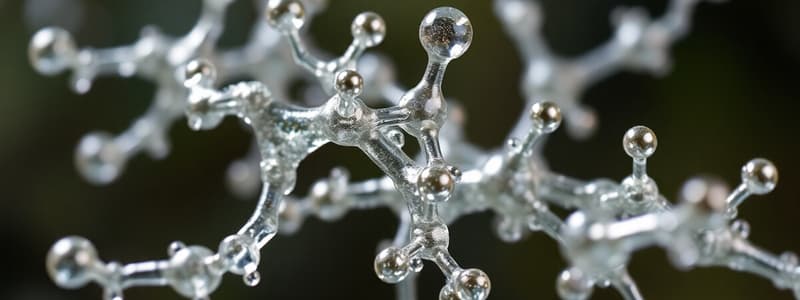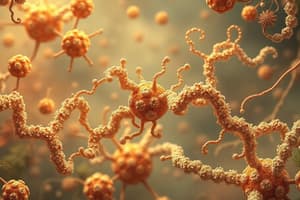Podcast
Questions and Answers
What is the primary role of enzymes in biological reactions?
What is the primary role of enzymes in biological reactions?
- To bind all substrates indiscriminately
- To produce heat
- To speed up chemical reactions (correct)
- To consume energy
Which characteristic is NOT typically associated with living organisms?
Which characteristic is NOT typically associated with living organisms?
- Growth
- Absence of cells (correct)
- Reproduction
- Metabolism
What component of a cell is responsible for organizing its genetic material?
What component of a cell is responsible for organizing its genetic material?
- Cytoplasm
- Nucleus (correct)
- Ribosome
- Cell membrane
What drives the process of diffusion?
What drives the process of diffusion?
Which of the following statements about enzymes is accurate?
Which of the following statements about enzymes is accurate?
Which group of living organisms primarily obtain nutrients through absorption?
Which group of living organisms primarily obtain nutrients through absorption?
What distinguishes prokaryotic cells from eukaryotic cells?
What distinguishes prokaryotic cells from eukaryotic cells?
What is the primary outcome of diffusion once equilibrium is reached?
What is the primary outcome of diffusion once equilibrium is reached?
Flashcards
Enzymes
Enzymes
Biological catalysts, mostly proteins, that speed up chemical reactions in living organisms.
Activation energy
Activation energy
The minimum energy required for a reaction to start.
Enzyme specificity
Enzyme specificity
Enzymes are very specific, typically catalyzing only one type of reaction.
Active site
Active site
Signup and view all the flashcards
Diffusion
Diffusion
Signup and view all the flashcards
Concentration gradient
Concentration gradient
Signup and view all the flashcards
Osmosis
Osmosis
Signup and view all the flashcards
Equilibrium
Equilibrium
Signup and view all the flashcards
Study Notes
Enzymes
- Enzymes are biological catalysts, typically proteins, that accelerate chemical reactions in living organisms.
- They function by lowering the activation energy needed for a reaction to occur.
- Enzymes are highly specific, meaning they typically catalyze only one type of reaction.
- Enzyme activity is affected by factors such as temperature and pH.
- Enzymes have an active site, a specific region where the substrate binds.
- The substrate binds to the active site resulting in an enzyme-substrate complex.
- The reaction occurs, and the product is released from the enzyme.
- Enzymes can be regulated to control the rate of the reactions they catalyze.
- Enzyme inhibition happens when a molecule binds to the enzyme and reduces its activity.
Characteristics and Classification of Living Organisms
- Living organisms share several key characteristics:
- Organization: Composed of cells.
- Metabolism: Carry out chemical reactions to obtain energy and build materials.
- Growth: Increasing in size and complexity.
- Adaptation: Adjusting to the environment.
- Response: Reacting to stimuli.
- Reproduction: Producing offspring.
- Homeostasis: Maintaining a stable internal environment.
- Living organisms can be classified into various groups such as:
- Bacteria: Prokaryotic, unicellular organisms.
- Archaea: Prokaryotic, often found in extreme environments.
- Protists: Eukaryotic, unicellular organisms or simple multicellular organisms.
- Fungi: Eukaryotic, obtain nutrients through absorption.
- Plants: Eukaryotic, multicellular organisms that primarily perform photosynthesis.
- Animals: Eukaryotic, multicellular organisms that obtain nutrients by ingestion.
Cell Structure and Organisation
- Cells are the basic units of life.
- There are two main types of cells: prokaryotic and eukaryotic.
- Prokaryotic cells lack a nucleus and membrane-bound organelles.
- Eukaryotic cells have a nucleus and membrane-bound organelles, such as mitochondria and the endoplasmic reticulum.
- Cellular organization typically involves specialized cells working together in tissues, tissues forming organs, and organs forming organ systems.
Diffusion and Osmosis
- Diffusion is the net movement of molecules from a region of high concentration to a region of low concentration.
- The driving force behind diffusion is the concentration gradient.
- Diffusion continues until equilibrium is reached, where there is an equal concentration of molecules throughout a space.
- Diffusion occurs in liquids and gases.
- Osmosis is the movement of water across a semi-permeable membrane from a region of high water concentration to a region of low water concentration.
- Osmosis is a type of diffusion that specifically involves water molecules.
- The concentration of solutes affects water movement in osmosis, as water moves to equalize the concentration of solutes on both sides of the membrane.
- Osmosis is crucial for maintaining the water balance within cells and organisms.
- Different environments affect cells differently depending on the relative concentration of solutes inside and outside the cell (hypotonic, isotonic, hypertonic).
Studying That Suits You
Use AI to generate personalized quizzes and flashcards to suit your learning preferences.




